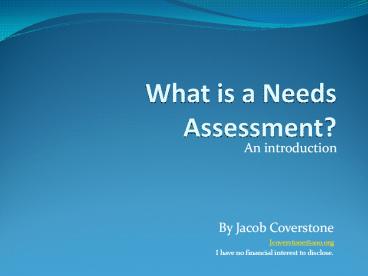What is a Needs Assessment? PowerPoint PPT Presentation
1 / 23
Title: What is a Needs Assessment?
1
What is a Needs Assessment?
- An introduction
By Jacob Coverstone
Jcoverstone_at_aao.org I have no financial interest
to disclose.
2
Objectives
- Attendees will be able to
- Define Needs Assessment
- Create and utilize an outline for conducting a
Needs Assessment - Understand types of identified needs
- Normative
- Relative
- Expressed
- Perceived
3
When do you conduct a Needs Assessment?
- A Needs Assessment takes place before the
activity is designed.
4
Why do you conduct a Needs Assessment?
- The purpose of a Needs Assessment is to make
decisions regarding priorities for the program. - If you conduct a proper Needs Assessment, you
will address or support 9 of the 22 Updated
Criteria and 3 of 7 Essential Elements C2, C3,
C4, C6, C16, C18, C19, C21, C22, E2.1, E2.2, E2.3
5
Needs Assessments are about Evidence
- Can you answer
- what evidence do we have that our audience needs
this education? - what evidence do we have that our solution will
yield positive results? - what is the reason that we are offering
education in this format?
6
It depends on what the meaning of the word 'is'
is Former President Bill Clinton
- Definitions 1
- Gap
- Need
- Want
- Assessment
- Needs Assessment
7
Definitions 1
- Gaps
- The space between what currently exists and what
should exist. - Needs are contributing factors
- What needs to be resolved to help close a gap.
- Needs often relate to barriers
- Wants are possible solutions
- A proposed means to filling the gap.
- Assessment is the evaluation of needs, barriers
and resources.
8
Definitions 1, continued.
- Needs Assessment is the process of identifying
and measuring areas for improvement in a target
audience, and determining the methods to achieve
improvement.
So important, it has its own slide.
9
What goes into a Needs Assessment?
- Normative data
- Evaluations
- Objectives
- Opinion
- Timelines
- Barriers
- Resources
What does it take to get your activity off the
ground?
10
So what is a Needs Assessment?
Pre-Assessment
Needs Assessment
Assessment
Action Plan
11
Phases of a Needs Assessment
- Pre-Assessment
- Data collection. What do we know?
- This is the foundation of Gap Analysis
- What is the current state?
- Where should we be?
- How does our region compare to others?
- Whats new?
- Whats important?
12
Phases of a Needs Assessment
- Assessment
- Evaluation of the data
- What are our barriers?
- Both internal and external
- What Needs have we identified?
- Are some gaps bigger than others?
- Consider both scope and severity
- What are our priorities?
- Do we have the resources to address them?
- Why do anything at all?
13
Phases of a Needs Assessment
- Action Plan
- How are we going to translate what we have into
what they need? - Which Needs can we address?
- How are we overcoming barriers?
- List additional barriers hindering progress
- Have any areas been identified for follow-up or
future opportunities for educational
intervention?
14
Gathering Data
- Search for objective measures
- Scope How many, or what percent, of patients are
exposed/vulnerable/expected to suffer from - Severity What are the consequences?
- Discomfort? Pain? Blindness?
- Are there national standards for treatment?
- Can we do better?
15
Assessment, an example
- It's 106 miles to Chicago, we got a full tank of
gas, half a pack of cigarettes, it's dark, and
we're wearing sunglasses. - - Elwood Blues, The Blues Brothers
16
It's not what you know, it's how you know it.
- Needs (gaps) are identified in 4 ways
- Types of Need
- Normative
- Relative
- Expressed
- Perceived
17
Types of Need
- Normative
- Defined as falling below a standard criterion
established by custom, authority, or general
consensus. - Strength
- Allows planners to use objective targets
- Weakness
- Need levels change with time and must be
re-evaluated
18
Types of Need, cont.
- Relative
- Measured by the gap between the level of service
between similar communities - Strength
- Can lead to a priority for distribution of
limited resources - Weakness
- Limits resource allocation to under-performing
areas
19
Types of Need, cont.
- Expressed
- Defined in terms of the number of people who
actually have sought help - Strength
- Focuses on situations where people have taken
action - Helps to determine barriers
- Weakness
- Not all people with Needs seek help
- Loss of the bigger picture
- Misses latent Needs
20
Types of Need, cont.
- Perceived
- Defined in terms of what people think their needs
are or feel their needs to be - Strength
- Easy to come by
- Weakness
- Subjective
- Subject to the Dunning-Kruger effect
21
Problems must be translated into Needs
- Strive to answer all 4 types of Need.
- Each type of need paints a different picture of
the gap.
22
Needs are translated into Objectives
- But thats another talk
23
Remember
- Want and Need are not synonyms.
- A Needs Assessment is conducted before the
activity is planned. - Pre-Assessment is not enough.
- The more types of need you consider, the richer
the planning process and the more effective the
education. - What gets measured gets managed Peter
Drucker.

